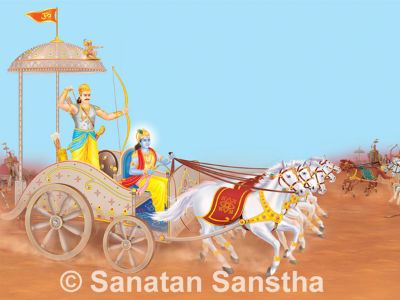
Contents
- 1. Holy texts of the Smrutis
- 2. The Manusmruti
- 3. The Yadnyavalkyasmruti
- 4. The Ramayan
- 5. The Yogavasishtha
- 6. The Mahabharat
- 7. The Shrimadbhagvadgita
- 8. The Purans
- 9. The Bhagvatpuran
- 10. The Prasthanatrayi
1. Holy texts of the Smrutis
Besides the texts of the Smrutis the Mahabharat and Ramayan too are considered as the Smrutis. In the Mahabharat itself, it is referred to as the scripture on Righteousness (Dharmashastra) [Adiparva 2.283]. The commentaries (nibandha) on the scriptures of Righteousness (Dharmashastra) of course are innumerable.
Kamalakarbhatt wrote the holy text Nirnaysindhu in 1612 A.D. He has made a mention of a hundred authors of the Smrutis and three hundred essayists in His holy text. Thereafter towards the end of the 18th century A.D. the text Dharmasindhu was written. This essay was written by Kashinath Upadhyay or Baba Padhye on the scriptures of Righteousness (Dharma). In this way essayists emerged in all parts of India and received varying amounts of recognition in their respective regions.’ (1)
Information on some important texts is given below.
2. The Manusmruti
‘The Manusmruti available today has 12 adhyays (chapters) and 2694 verses (shlokas). In this it is stated that Manu has acquired the scriptures on Righteousness created by Lord Brahma and in turn He teaches it to the sages.
The topics in the Manusmruti can be described in brief as below.
The creation of the universe, the measurement of time right from a nimish (the duration required for the opening or closing of the eyelids) to even a day of Lord Brahma, dissolution of the universe (pralay), the deterioration of Righteousness, codes of Righteousness and objectives during different yugs (eras).
Definition and sites of origin of Righteousness, limitations of Aryavarta (land of Aryans), necessity of spiritual rites (sanskars) and their types, the rite of thread ceremony (upanayan), the duties and limitations of a celibate (brahmachari).
Marriage, duties of both spouses, the stage of the householder, the five great fire sacrifices (panchamahayadnya), the rite of shraddha for ancestors, the duties of a householder, the duties of a wife and a widow, the duties of the husband and wife as prescribed in the scriptures, the twelve kinds of sons, division of property, inheritance, different kinds of sins and the acts of atonement (prayashchitta) to be performed to nullify them, the seven types of servants (das).
Periods of impurity, permissible and forbidden foods, purity of substances
Duties of a retired householder (vanaprastha) and a renunciant (sannyasi)
The code of Righteousness of rulers (rajadharma), the sciences (vidya) to be learnt by a king, the undesirable qualities of a king, the cabinet of ministers, officers, the royal assembly, the six attributes in making peace or war (sandhivigraha)
Meting out justice, points for debate, judges, different types of crimes and the punishment for them, excise, prisons
Privileges and duties of all the four classes, inter-caste communities, the right ways to procure wealth and to earn a livelihood
Making offerings, acts of atonement (prayashchitta), visible effects of sins committed in previous births, a variety of acts of atonement, mantras to nullify sins.
Discussion on actions, how ultimate benefaction can be obtained, that Self-realisation is the ultimate means of acquiring happiness, worldly and spiritual actions, knowers of the meaning of the Shrutis (shishta) and assemblies, results of studying anthropology.’(2)
3. The Yadnyavalkyasmruti
Yadnyavalkya has discussed most of the topics from the Manusmruti. He has also written the Shukla Yajurveda.
4. The Ramayan
This is called the foremost poetry (adikavya) and its poet Sage Valmiki the first poet (adikavi) as this is the first poetry in the history of mankind. This text has seven kands (parts) and 645 sargas (sections) of the poem. It is the biography of the Absolute Being, Shrirama born in the Ikshvaku dynasty. More information on Lord Rama is given in ‘Science of Spirituality : Vol. 8 – Vishnu and His Forms (including Maruti and Datta)’.
5. The Yogavasishtha
Its philosophy and special features are described below.
A. ‘The philosophy of effort (prayatnavad): “पूर्वजन्मकृतं कर्म तद्दैवमिति कथ्यते” means one has to face the results of whatever actions one has performed in the previous births in the next births as providence or destiny. The happiness and unhappiness that one experiences is associated with one’s own actions. Actions which cannot be directly connected to the cause of happiness and unhappiness are called invisible (adrushta), providential (praktan) or destined actions while those which can be directly connected to the cause of happiness and unhappiness are called effortful (paurush), willful or diligent actions. Thus the destiny spoken about by believers of fate is basically a consequence of actions. One should perform worldly actions using the power to discriminate between right and wrong but spiritual acts like performing fire sacrifices and the like should be performed using both one’s own intellect as well as assistance from the scriptures. In the context of spiritual knowledge, yoga and devotion however one should seek guidance from the scriptures and the Guru along with one’s own intellectual knowledge.
B. The embodied soul: When The Supreme Brahman develops the emotion that “I am a focus of light”, then that focus is called an embodied soul (jiva). That focus assumes a huge form through one’s emotion. In the same way through emotion itself does that focus assume dual forms of the viewer and the scene. Because of the development of the feeling that “I am someone” over a prolonged period within the embodied soul, ego develops within it. This embodied soul then remains bound by various desires created by it out of a resolve (sankalpa). Such embodied souls are infinite.
C. The universe: The principle associated with the origin of the universe is called the sattva principle. The manifest universe has been created from that very sattva principle. Before its manifestation, the universe remains in a state of dissolution in the sattva principle. At that time one cannot experience it in different forms and names. This state is said to be unmanifest (avyakta or avyakrut). The period of this unmanifest state is termed as the period of dissolution (pralay) in worldly terms. During this period all visible and invisible creation merges into the unmanifest still maintaining its subtlest desire. If the presence of desires in the subtle (bija) form in the unmanifest state is refuted then no diversification will occur in the universe; hence it seems necessary to acknowledge the presence and complexity of subtle desires during the time of dissolution. All creation undergoes destruction in the order reverse of that of creation during the period of dissolution.
D. The Supreme Brahman: In the Yogavasishtha the supreme principle is called Parabrahman.
E. The Final Liberation (Moksha): It is of two types, during embodiment (sadeha) and after death (videha).
असंसक्तमतेर्यस्य त्यागदानेषु कर्मणाम् ।
नैषणा तत्स्थितिं विद्घि त्वं जीवन्मुक्ततामिह ।। – ५.४२.१२Meaning: When there are absolutely no desires associated with the sacrifice of actions and in their performance in a detached person, that state is called Liberation during embodiment (jivanmukti). – 5.42.12
When an embodied soul does not need to take rebirth after death that state is called Liberation after death (videha mukti).
F. Absolute (samyak) knowledge: To attain the Final Liberation one has to attain Self-realisation. In fact it is the only means of attaining the Final Liberation. This spiritual knowledge bestowing the Final Liberation is described thus –
अनाद्यन्तावभासात्मा परमात्मेह विद्यते ।
इत्येको निश्चय: स्फार: सम्यक् ज्ञानं विदुर्बुधा: ।। – ५.७९.२Meaning: Developing the firm conviction that the eternal, infinite, self illumined Supreme Soul exists in this universe is called acquisition of Absolute knowledge by scholars. – 5.79.2
Development of the firm conviction that every object that increases or decreases in size are all but the soul and there is no principle other than the soul in the universe is acquiring absolute knowledge. This knowledge is not acquired easily. The worldly attraction experienced in hundreds of births is firm in the mind and to destroy that emotion one needs to acquire knowledge over a long period of time. One experiences Self-realisation if there is a perfect union of the triad of one having potential, study of the scriptures and a Guru.
G. Special features: This holy text has not objected to or countered the doctrines of other sects. The author of the Yogavasishtha is generous and expansive. He believes that all sects and their opinions are true. The same Supreme principle is referred to as Shunya (absolute zero) by the shunyavadi philosophy, Brahman by the Brahman philosophy, Vidnyan (pure knowledge) by the vidnyanvadi philosophy, Purush (the Absolute Being) by the Sankhya philosophy, God (Ishvar) by the yogi and Shiva by the Shaiva sect.’(3)
6. The Mahabharat ( fifth veda )
A. History: ‘After culmination of the Bharatiya war and coronation of Dharmaraj (Yudhishthir), Sage Vyas decided to write a book on the history of the Kauravs and Pandavs. He accomplished the task of writing a holy text called Jay, in Badari on the banks of the river Bhagirathi situated close to the Nara-Narayan mountains, within three years. This text includes the entire history of the Kauravs and Pandavs from their birth till the end of the Bharatiya war. According to scholars it contains approximately eight to ten thousand verses (shlokas). Janmejay was a monarch of the fourth generation of the Pandavs. He was keen on hearing the detailed history of his ancestors. So he asked the royal preceptor (rajguru) Sage Vaishampayan who narrated the entire history to him, from the beginning of the Paurav dynasty. The cause of his father, King Parikshit’s death was a snake bite. Janmejay was eager to hear about that incident as well. Hence Vaishampayan added that to the main text. In this way the account of the four or five generations of the Pandavs, from their ancestors to their descendants till King Janmejay, increased the content of the Jay text twofold thus making it triple of what it initially was. Its name was then changed to Bharat. This book compiled by Sage Vaishampayan has approximately thirty thousand verses (shlokas). Sauti compiled Bharat’s third edition. Sages like Shaunak, etc. who had gathered in the Naimish forest, invited Sauti alias Laumharshani, a son born out of an interclass marriage (sutputra) and requested Him to narrate the story of Bharat. The sages asked Him several questions and got Their doubts clarified. When answering them Sauti told Them some fables and parables. Inclusion of all this increased Sauti’s book and made it larger than the Bharat. The number of verses (shlokas) in it rose from thirty thousand to a hundred thousand. He compiled this great text in such a way that there was no inconsistency with the main text. This is the manifestation of His fabulous intellect. The period around 250 B.C. is most certainly that of the Mahabharat.
B. Importance
Lucid and comprehensive nature: It has been glorified as ‘भारतं पञ्चमो वेद: i.e. the Mahabharat is the fifth Veda ’ meaning that from the historical point of view the greatness of the Mahabharat is second only to the Vedas. The Vedas, most sections of which are filled with the praise of deities and the description of sacrificial fires, are written in the ancient Sanskrut language of the Aryans. That is why the inferences arising from Vedic literature are vague and unclear. On the contrary the Mahabharat is written in the present day Sanskrut language and hence is generally lucid.
It is a compilation of the historical events of the ancient period. The praise of the Mahabharat sung at its beginnng is in a way befitting it. It goes thus –
धर्मे चार्थे च कामे च मोक्षे च पुरुषर्षभ ।
यदेहास्ति तदन्यत्र यन्नेहास्ति न तत्क्वचित् ।Meaning: O great man, you will come across whatever is written in this holy text about the four pursuits (purusharthas), that is Righteousness (Dharma), wealth (artha), desire (kama) and the Final Liberation (Moksha) in all other texts and whatever is not given here will not be found anywhere.
Glorification of Righteousness: The chief objective of the Mahabharat is defining Righteousness and explaining it. When describing any event, Sage Vyas’ expansive motive was only to preach Righteousness. Throughout the Mahabharat there is a constant mention of Righteousness ‘यतो धर्मस्ततो जय: meaning victory prevails where there is Righteousness’ which is the slogan of the Mahabharat. The four verses (shlokas) called Bharatsavitri which are present in the concluding part of this holy text express Righteousness as the sole motive of this holy text. One of the verses from it says –
न जातु कामान्न भयान्न लोभात् धर्मं त्यजेज्जीवितस्यापि हेतो: ।
नित्यो धर्म: सुखदु:खे त्वनित्ये नित्यो जीवो धातुरस्य त्वनित्य: ।।Meaning: One should never forsake Righteousness out of desire, fear, greed or fear of loss of life because Righteousness is permanent while happiness and unhappiness are only momentary. The embodied soul is eternal while the gross body is temporary.
On the pretext of writing the story of the Mahabharat, Sage Vyas transformed the events on the battlefield into a Sanhita (commentary) on Righteousness. Just as the Gayatri mantra summarises the Vedas so also Righteousness is the gist of the Mahabharat.’(4)
Sage Vyas’ divine intellect: ‘Out of all the holy texts and literary works written by Sage Vyas, the Mahabharat has received divine accolades. Vyas has presented all the three Darshans of life such as the science of economics (arthashastra), the science of Righteousness (Dharmashastra) and the science of the Final Liberation (Mokshashastra) in beautiful, interesting stories using flowery language. Enlightenment of detailed knowledge about the Aryan race and their expansive social life occurs through it.
In the real sense the Mahabharat is an encyclopaedia of ancient India (Bharat). It is a renowned epic in world literature. On one hand the Mahabharat is an eternal treasure house of morality and Righteousness (Dharma) and on the other a compilation of the ancient eternal science of unmetrical compositions (gathashastra). Sage Vyas has not written the Mahabharat simply enumerating the events of the past, were it so then it would merely gather dust in a bookcase like any other historical text. However the Mahabharat is presented before us as a live event.
Food for poets: The Mahabharat is an unending treasure of topics for poets. Great Sanskrut poets like Kalidas, Bharavi, Magh, etc. have chosen their main topics of poetry from the Mahabharat itself. The tradition of selecting a story or event from the Mahabharat and transforming it into poetry is continuing even today.’(5)
C. The radiant Mahabharat: ‘Just like wealth and the effulgence of a warrior (kshatratej) industriousness or efforts comprises the third part of the material code of Righteousness. In the Mahabharat one comes across great men like Krushna, Bhishma, Bhim, Arjun, etc. who constantly praise efforts. Lord Shrikrushna (Mahabharat 5.77) has said, “Man should continue his efforts. He should not become weak, depressed or helpless only because of his bad destiny.”
Caution, concentration and bravery are also praised on various occasions in the Mahabharat. After reading quotes in this regard one is able to appreciate the worldly code of Righteousness from the Mahabharat. A prosperous kingdom, an opulent lifestyle, a powerful empire were the great expectations imprinted upon the minds of those men. They wished that people should untiringly strive towards this. They did not appreciate criticism of the six foes of the soul (shadripu). They were fully aware that man cannot perform valorous deeds without rage, anger and desire for opulence. They had realised that without bravery and the preparedness to die or to kill one could not acquire opulence. This holy text mainly inspires worldly progress, the paths to achieve it and explicitly substantiates that everything is futile without worldly splendour. This great text creates the aspirations of worldly opulence, conquest of the world, fame resounding in all the three regions of earth, heaven and the nether world, etc. in the mind of man and inspires him to undertake war and to be prepared to die or kill.’(6)
D. Some implied meanings from the Mahabharat: Pandit Narendra Sharma says – Yudhishthir is in reality the absolute ether (akash) element. He maintains the balance between happiness and unhappiness, but his attraction for a game of dice and the consequences arising from it are his fate. Arjun represents the absolute fire element, Bhim is the absolute air or vital energy element, Nakul the absolute water element and Sahadev the absolute earth element. Thus they are representatives of the cosmic elements. Draupadi is the union of the five cosmic elements, the upward flowing energy of life who has emerged from the altar of the fire sacrifice (hom). However she is less virtuous because of the subtle discrimination that she makes between her husbands. Duryodhan can be summed up as the obstinacy of King Dhrutarashtra. Karna is very powerful, capable of sacrificing everything, very generous; but shadowed by tremendous ego which is the only ‘defect’ in his invincible armour. Need one speak anything on Lord Shrikrushna ? He is an absolute incarnation (purnavtar), the centre of attraction of the entire Mahabharat.
7. The Shrimadbhagvadgita
The Shrimadbhagvadgita narrated by Lord Shrikrushna to Arjun is the jewel in the crown of the Mahabharat. Chapters 25 to 42 of the Bhishmaparva of the Mahabharat narrate the Gita. It is considered as the main holy text of the Hindu religion (Dharma) and of morality (niti) as well. The word Shrimadbhagvadgita can be explained as –
| Shrimad (t) : | That sung by The Lord |
| Bhag : | Like the sun (bhag means effulgence) |
| Vad (t) : | That assisting in displaying its light |
| Gita : | Song (git) |
Just as the Mahabharat has 18 parvas, the Gita has 18 adhyays (chapters). At no point is the style of the Gita uninteresting. Its main objective is to teach Spirituality. Unlike the Buddhist Dhammapad it is not confined only to teaching morality. The notes of the Gita are so melodious that one feels that one is being showered with the divine nectar of words, by a friend. This mode of speech of Lord Shrikrushna has generated from Sage Vedavyas in the superconscious (samadhi) state.
‘The pradnyavad (philosophy of intellect) is a vast Darshan of those times. Krushna followed this philosophy. Buddha too belonged to this school of thought but when following it He was influenced by the path of self-abnegation as that of an ascetic and He accepted the tradition of renunciation of the Sankhyas which is predominantly based on sacrifice of worldly life. Krushna used the basis of the Vedic Path of Action (Karmayoga). Along with this philosophy, on one hand He accepted actions (karma) and the four pursuits of life (purusharthas) and on the other also substantiated a vision of the effulgent Brahman which has evolved from the Vedic school of thought. Apart from this He appropriately honoured the philosophies of the Sankhya followers like those of Sage Kapil.’(7)
8. The Purans
A. Meaning: ‘पुरा नवं भवती ।’ means that which is ever new despite being old, is the Puran.
B. Importance
The Purans follow the Shrutis and Smrutis in the order of importance. A quote ‘श्रुतिस्मृतिपुराणोक्त फलप्राप्त्यर्थं’ meaning that ‘one derives benefits according to that prescribed in the Shrutis, Smrutis and Purans’ is found in the resolve (sankalpa) in all religious rituals.
In modern times the Purans are the main support of the worldly code of Righteousness (Dharma) of a follower of Hinduism.
The Purans are accorded the highest status in popular Sanskrut literature. Authors of the Purans have shown the path of upliftment to men and women belonging to all castes and communities along with the code of Righteousness for those following the Vedas and the three classes (varna) namely Brahmans (priests), Kshatriyas (warriors) and Vaishyas (businessmen).
The Purans narrate stories to illustrate a point . The history being from different kalpas (periods of time) in the same volume there is a slight difference in stories of the contemporary times. Different spiritual doctrines are delivered through these stories. However some stories are totally imaginary.
C. Important Purans: The eighteen Purans are named differently in various Purans. The main Purans as given in the Matsyapuran (chapter 53) are : Brahman, Padma, Vishnu, Vayu, Bhagvat, Naradiya, Markandeya, Agneya, Bhavishya, Brahmavaivarta, Linga, Varaha, Skanda, Vaman, Kurma, Matsya, Garud and Brahmand. The other Purans have substituted some of these Purans by alternative ones. The Bhagvatpuran is the most popular among all the Purans. It is described below.
8.1 The sub-Purans (upapurans)
‘The Purans other than the eighteen great Purans from Sanskrut literature are called the sub-Purans. They are related to some great Purans (Mahapurans). It is an age old misconcept that they were composed after the great Purans and are inferior in status. However it has been proven that some sub-Purans are even older than the great Purans.
Since the Vedic period the Purans are prevalent in the form of literature by Sage Sut. The Vedic Aryans accorded importance to them immediately after the Vedas. Over the passage of time the spread of Buddhism and Jainism came as a blow to the Vedic religion. So the Smart (followers of the Smrutis) Brahmans utilised the Purans to resurrect their own sects and on their basis re-established the code of Righteousness of the classes and stages of life (varnashramdharma). In those days the three sects worshipping the deities Brahma, Vishnu and Mahesh were the Brahma, Pancharatra and Pashupat sects respectively. Later during the reign of the Gupta dynasty the Bhagvat sect flourished.
The Purans written by Brahmans of the Smart sect became famous as the great Purans (Mahapurans). Their compilation had begun before the commencement of the Christian calendar. After their completion they were eighteen in number. The number was probably fixed at eighteen because it is considered as an auspicious figure. Sub-sects of the Brahma, Pancharatra and Pashupat sects sprung up thereafter. The Smarts in these sects wrote new Purans. Believers of the eighteen Purans did not accept these new Purans; however because of their fame and popularity they had to be accorded at least a secondary status. That is why by inserting some verses (shlokas) in the Matsyapuran the new Purans were renamed as the sub-Purans.
Since the great Purans were considered superior and the authority, they were expanded through additions made in them. That is why the great Purans available today are not reliable historically. This was not the case with the sub-Purans. They were accorded a secondary status; hence neither were new styles incorporated in them nor were any additions made. Consequently their original format remained unchanged so the information contained in them is more reliable.’(8)
9. The Bhagvatpuran
‘Maharshi Vyas divided the Vedic compositions into four parts (Vedas). Despite writing the Brahmasutras, eighteen Purans and the Mahabharat (Jay) His mind was still restless. Specially when writing the Mahabharat, as Vyas had to describe various wars, plots and conspiracies, destruction of the army of eighteen hundred trillion on the battlefield of Kurukshetra and the melancholic frustration spread over India as its consequence, He felt dejected and restless. When in such a state He met Sage Narad whom He told His woe, Sage Narad replied, “You have not described The Lord’s immaculate success in detail. You have not described Lord Vasudev’s glory at all. Though the scripture bestows spiritual knowledge, if it does not teach devotion unto The Lord, then it is inappropriate. You have illustrated the path of materialism (pravruttimarg) but remember that other than devotion unto The Lord there is no other means of realising Him. So write a separate holy text narrating the biography of Shrikrushna with devotion and spiritual emotion. That will rid You of Your restlessness.”
Thereafter Vyas devotedly began writing the Bhagvatpuran and in its tenth skanda (volume) wrote the entire biography of Lord Krushna. He was able to write on the unparalleled hero, The Lord of Yoga (Yogeshvar) Krushna. As a result His devotion began to flow like the river Bhagirathi and His spiritual intellect blossomed anew. He composed several exquisite verses (stotras) on Krushna. Thus the Bhagvat came to be established as an epic of devotion. After completing this text, Vyas was at peace with Himself.’(9) This example amply illustrates that the Path of Devotion (Bhaktiyoga) is superior to the Paths of Action (Karmayoga) and Knowledge (Dnyanyoga). After its completion, Vyas read it out to Shuk, His son who had already totally renounced the world !
10. The Prasthanatrayi
‘The Upanishads, Vedantasutras and Bhagvadgita are the three precious holy texts of Indian philosophy. Their triad is referred to as the Prasthanatrayi.
In the Prasthanatrayi, the Upanishads occupy the first position. They are the absolute authority. The authenticity of the other two texts in this triad is based on the Upanishads. The Upanishads are also known as the Shrutiprasthan. It includes the Ish, Ken, Kath, Prashna, Mundak, Mandukya, Taittiriya, Aitareya, Chandogya, Bruhadaranyak, Kaushitaki and Shvetashvatar, the twelve main Upanishads. The ‘Vedanta’ is a synonym for the Upanishads and has actually appeared in one or two ancient Upanishads (Mundak 3.2.6, Shvetashvatar 6.22). As against this, the Vedantasutras or the Vedantadarshans are often referred to as the Vedanta. The Vedanta refers to the end (anta) of the Vedas implying that it is the very culmination of the study of Vedic literature.
The Vedantasutras are also called the Nyayaprasthan, Vedanta, Vedantadarshan, Brahmasutras, Sharirak Mimansa or Uttarmimansa. Sage Badarayan or Krushnadvaipayan is the author of these Sutras. He is also known as Vedavyas.’(10)
The Bhagvadgita and the Sanatsujat Sanhita are called the Smrutiprasthan.
Reference:
‘Righteousness (Dharma)’, published by Sanatan Sanstha.
Bharatiya Sanskrutikosh. Publisher: Pandit Mahadevshastri Joshi, Secretary, Bharatiya Sanskrutikosh Mandal, 410 Shanivar Peth, Pune 411 030.
First edition: Vol. 3 to 10, Second edition: Vol. 1 and 2
[1]. Vol. 4, Pg. 596-599 [3]. Vol. 7, Pg. 674-677
[4]. Vol. 7, Pg. 155-182 [5]. Vol. 9, Pg. 159
[6]. Vol. 7, Pg. 173-175 [7]. Vol. 7, Pg. 182
[8]. Vol. 1, Pg. 673 [9]. Vol. 9, Pg. 160-161
[10.] Vol. 5, Pg. 738[2]. Dharmashastracha Itihas. Second edition : 1980, Publisher: Secretary, Maharashtra State Literary and Cultural Society, Secretariat, Mumbai 400 034., Pg. 48-49

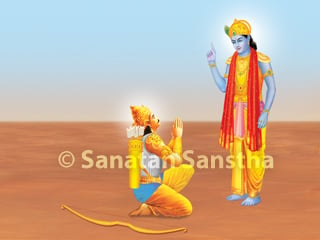
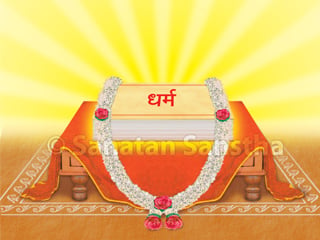 What is the true meaning of word Dharma (Righteousness) ?
What is the true meaning of word Dharma (Righteousness) ?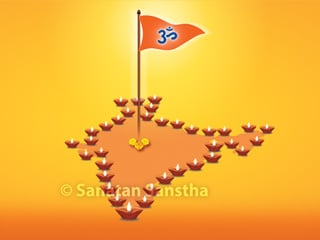 Dharma (Righteousness) and the importance of India (Bharat)
Dharma (Righteousness) and the importance of India (Bharat)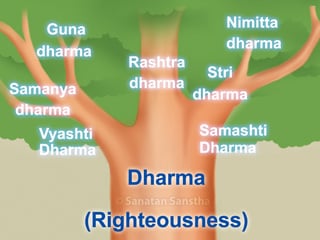 Types of Dharma (Righteousness)
Types of Dharma (Righteousness)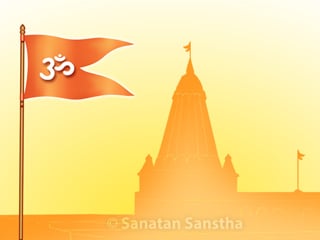 Hindu Dharma
Hindu Dharma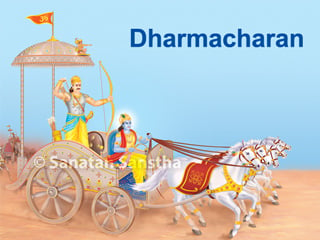 Why is it essential to adhere to Righteousness (Living Dharma) ?
Why is it essential to adhere to Righteousness (Living Dharma) ?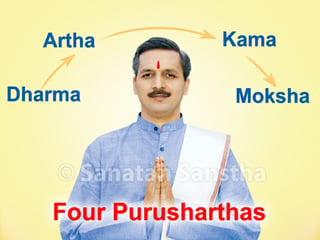 Dharmasiddhant - Principles of Hinduism (Doctrines of Dharma [Righteousness] )
Dharmasiddhant - Principles of Hinduism (Doctrines of Dharma [Righteousness] )